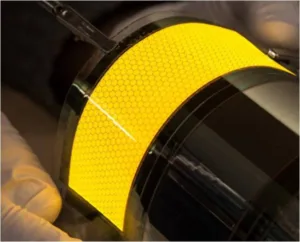Flex-o-Fab, the European research program for OLED, has reported the first OLED device produced by a roll to roll process. The program includes 12 European companies and organizations from different fields which came together to create a a roll to roll (R2R) process for OLED. The co-operation is funded through the EU’s 7th EU Framework Programme for Research (FP7) under the leadership of the Holst Centre.
The goal of the program is to develop a roll to roll process for flexible OLED within three years of completion of the project. The program started in October 2012 and is funded for three years until September 2015.
As can be seen in the following image, this project is not aimed at creating a display, but aims to create OLED flexible lighting panels. This could also be used for backlighting, though this is not obvious from the project goals. It is expected that this project will drastically reduce the production cost.
The main goal is not the development of OLED emitters but the development of a process that takes the sheet to sheet process and transports it to a roll to roll process. Since the program is aimed at lighting there is no mask step for depositing the small molecule emitter layer.
One of the key challenges for such a process is the barrier layer. Since it starts with a flexible PET film as the base substrate, the project needs to create a barrier layer that will create a reasonable life time of the device. The new barrier film developed by the Holst Centre has succeeded in producing a 2.5 km (roughly 1.5 miles) long PET film with water vapor transmission rates (WVTR) lower than 10-5 g/m² per day. It uses an in-situ planarization of the commercial PET film. This is similar to WVTR achieved in sheet to sheet processes.
According to the press release, the rest of the processes are more conventional at the moment. The film was bonded to carrier glass sheets and then processed with conventional equipment. While specific performance data was not released, the release stated that the devices perform in a similar way to devices produced in a sheet to sheet process and rigid devices on glass.
Partners in the program are
- Holst Centre / TNO (Project coordinator) [Netherlands]
- Philips Research [Netherlands, Germany]
- Philips GmbH [Germany]
- Orbotech Ltd. [Israel]
- École Polytechnique Fédérale de Lausanne (EPFL) [Switzerland]
- Henkel Electronics Materials N.V. [Belgium]
- SPGPrints B.V. [Netherlands]
- Epigem Ltd. [UK]
- Tampere University of Technology (TUT) [Finland]
- Roth & Rau AG Business Unit MicroSystems [Germany]
- Dupont Teijin Films UK Ltd (DTF) [UK]
- CSEM [Switzerland]
Display Daily Comment
This program may create a good starting point for flexible displays as well. There are more hurdles to overcome and many R2R approaches bank on printing OLEDs today. This additional hurdle adds a considerable amount of time and research cost. Nevertheless, this project adds an achievable goal for R2R OLED processing to bring this technology to the market in the near future. Printed flexible OLED displays will certainly follow later. – Norbert Hildebrand

